Time Series Analysis of Vegetation Recovery After the Taum Sauk Dam Failure
Abstract
1. Introduction
2. Materials and Methods
2.1. Study Site
2.2. Satellite Data Collection
2.3. Remote Sensing and GIS Analysis
2.3.1. Normalized Difference Vegetation Index
2.3.2. Processing Remotely Sensed Images
2.3.3. Summarizing NDVI Data
2.4. Ground Truthing Surveys
3. Results
3.1. Dynamics of NDVI After the Taum Sauk Dam Failure
3.2. Ground Truthing Results
3.2.1. Validation of NDVI Inferences
3.2.2. Community Dynamics of the Restoration
3.2.3. Collared Lizards as a Bioindicator
4. Discussion and Conclusions
4.1. The Dynamic Change Pattern of Vegetation After Disturbance
4.2. Bioindicators for Vegetation Recovery After the Taum Sauk Dam Failure
4.3. The Limitations and Outlook
5. Future Directions
Supplementary Materials
Author Contributions
Funding
Data Availability Statement
Acknowledgments
Conflicts of Interest
References
- Rogers, J.D.; Watkins, C.M.; Chung, J.W. The 2005 upper Taum Sauk dam failure: A case history. Environ. Eng. Geosci. 2010, 16, 257–289. [Google Scholar] [CrossRef]
- Watkins, C.M.; Rogers, J.D. Overview of the Taum Sauk Pumped Storage Power Plant Upper Reservoir Failure, Reynolds County, MO. In Proceedings of the International Conference on Case Histories in Geotechnical Engineering, Arlington, VA, USA, 11–16 August 2008; Missouri University of Science and Technology: Rolla, MO, USA, 2008; pp. 1859–1879. [Google Scholar]
- Mei, S.; Zhong, Q.; Yang, M.; Chen, S.; Shan, Y.; Zhang, L. Overtopping-Induced breaching process of concrete-faced rockfill dam: A case study of Upper Taum Sauk dam. Eng. Fail. Anal. 2023, 144, 106982. [Google Scholar] [CrossRef]
- Askar, S.; Peyma, S.Z.; Yousef, M.M.; Prodanova, N.A.; Muda, I.; Elsahabi, M.; Hatamiafkoueieh, J. Flood Susceptibility Mapping Using Remote Sensing and Integration of Decision Table Classifier and Metaheuristic Algorithms. Water 2022, 14, 3062. [Google Scholar] [CrossRef]
- Atefi, M.R.; Miura, H. Detection of Flash Flood Inundated Areas Using Relative Difference in NDVI from Sentinel-2 Images: A Case Study of the August 2020 Event in Charikar, Afghanistan. Remote Sens. 2022, 14, 3647. [Google Scholar] [CrossRef]
- Garajeh, M.K.; Weng, Q.H.; Haghi, V.H.; Li, Z.; Garajeh, A.K.; Salmani, B. Learning-Based Methods for Detection and Monitoring of Shallow Flood-Affected Areas: Impact of Shallow-Flood Spreading on Vegetation Density. Can. J. Remote Sens. 2022, 48, 481–503. [Google Scholar] [CrossRef]
- Nab, A.W.; Kumar, V.; Rajapakse, R. Innovative methods for rapid flood inundation mapping in Pul-e-Alam and Khoshi districts of Afghanistan using Landsat 9 images: Spectral indices vs. machine learning models. Model. Earth Syst. Environ. 2024, 10, 2495–2513. [Google Scholar] [CrossRef]
- Abrar, M.F.; Iman, Y.E.; Mustak, M.B.; Pal, S.K. Assessment of vulnerability to flood risk in the Padma River Basin using hydro-morphometric modeling and flood susceptibility mapping. Environ. Monit. Assess. 2024, 196, 661. [Google Scholar] [CrossRef]
- Al-Kindi, K.M.; Alabri, Z. Investigating the Role of the Key Conditioning Factors in Flood Susceptibility Mapping Through Machine Learning Approaches. Earth Syst. Environ. 2024, 8, 63–81. [Google Scholar] [CrossRef]
- Arabameri, A.; Saha, S.; Chen, W.; Roy, J.; Pradhan, B.; Bui, D.T. Flash flood susceptibility modelling using functional tree and hybrid ensemble techniques. J. Hydrol. 2020, 587, 125007. [Google Scholar] [CrossRef]
- Bui, D.T.; Khosravi, K.; Shahabi, H.; Daggupati, P.; Adamowski, J.F.; Melesse, A.M.; Pham, B.T.; Pourghasemi, H.R.; Mahmoudi, M.; Bahrami, S.; et al. Flood Spatial Modeling in Northern Iran Using Remote Sensing and GIS: A Comparison between Evidential Belief Functions and Its Ensemble with a Multivariate Logistic Regression Model. Remote Sens. 2019, 11, 1589. [Google Scholar] [CrossRef]
- Chithra, K.; Binoy, B.V.; Bimal, P. Modeling flood susceptibility on the onset of the Kerala floods of 2018. Environ. Earth Sci. 2019, 83, 123. [Google Scholar] [CrossRef]
- Hoang, D.V.; Liou, Y.A. Assessing the influence of human activities on flash flood susceptibility in mountainous regions of Vietnam. Ecol. Indic. 2024, 158, 111417. [Google Scholar] [CrossRef]
- Yang, H.L.; Yao, R.; Dong, L.Y.; Sun, P.; Zhang, Q.; Wei, Y.; Sun, S.; Aghakouchak, A. Advancing flood susceptibility modeling using stacking ensemble machine learning: A multi-model approach. J. Geogr. Sci. 2024, 34, 1513–1536. [Google Scholar] [CrossRef]
- Ghosh, A.; Chatterjee, U.; Pal, S.C.; Towfiqul Islam, A.R.M.; Alam, E.; Islam, M.K. Flood hazard mapping using GIS-based statistical model in vulnerable riparian regions of sub-tropical environment. Geocarto Int. 2023, 38, 2285355. [Google Scholar] [CrossRef]
- Kumar, R.; Acharya, P. Flood hazard and risk assessment of 2014 floods in Kashmir Valley: A space-based multisensor approach. Nat. Hazards 2016, 84, 437–464. [Google Scholar] [CrossRef]
- Rihan, M.; Mallick, J.; Ansari, I.; Islam, M.R.; Hang, H.T.; Shahfahad; Rahman, A. Flash flood susceptibility modeling using optimized deep learning method in the Uttarakhand Himalayas. Earth Sci. Inform. 2025, 18, 24. [Google Scholar] [CrossRef]
- Singha, C.; Swain, K.C.; Meliho, M.; Abdo, H.G.; Almohamad, H.; Al-Mutiry, M. Spatial Analysis of Flood Hazard Zoning Map Using Novel Hybrid Machine Learning Technique in Assam, India. Remote Sens. 2022, 14, 6229. [Google Scholar] [CrossRef]
- Stateczny, A.; Praveena, H.D.; Krishnappa, R.H.; Chythanya, K.R.; Babysarojam, B.B. Optimized Deep Learning Model for Flood Detection Using Satellite Images. Remote Sens. 2023, 15, 5037. [Google Scholar] [CrossRef]
- Nhu, V.H.; Ngo, P.T.T.; Pham, T.D.; Dou, J.; Song, X.; Hoang, N.D.; Tran, D.A.; Cao, D.P.; Aydilek, I.B.; Amiri, M.; et al. A New Hybrid Firefly-PSO Optimized Random Subspace Tree Intelligence for Torrential Rainfall-Induced Flash Flood Susceptible Mapping. Remote Sens. 2020, 12, 2688. [Google Scholar] [CrossRef]
- Qin, X.L.; Shi, Q.; Wang, D.Z.; Su, X. Inundation Impact on Croplands of 2020 Flood Event in Three Provinces of China. IEEE J. Sel. Top. Appl. Earth Obs. Remote Sens. 2022, 15, 3179–3189. [Google Scholar] [CrossRef]
- Shrestha, R.; Di, L.P.; Yu, E.G.; Kang, L.; Shao, Y.Z.; Bai, Y.Q. Regression model to estimate flood impact on corn yield using MODIS NDVI and USDA cropland data layer. J. Integr. Agric. 2017, 16, 398–407. [Google Scholar] [CrossRef]
- Wang, Q.; Watanabe, M.; Hayashi, S.; Murakami, S. Using NOAA AVHRR data to assess flood damage in China. Environ. Monit. Assess. 2003, 82, 119–148. [Google Scholar] [CrossRef] [PubMed]
- Isaacson, S.; Armoza-Zvuloni, R.; Babad, A.; Swiderski, N.B.; Segev, N.; Shem-Tov, R.; Stavi, I. Mass tree uprooting during a mega flash flood in the hyper-arid Wadi Zihor, southern Israel. Catena 2024, 242, 108133. [Google Scholar] [CrossRef]
- Silveira, E.M.D.O.; Acerbi, F.W.; de Mello, J.M.; Bueno, I.T. Object-based change detection using semivariogram indices derived from NDVI images: The environmental disaster in Mariana, Brazil. Cienc. E Agrotecnol. 2017, 41, 554–564. [Google Scholar] [CrossRef]
- Verma, S.; Sharma, A.; Yadava, P.K.; Gupta, P.; Singh, J.; Payra, S. Rapid flash flood calamity in Chamoli, Uttarakhand region during Feb 2021: An analysis based on satellite data. Nat. Hazards 2022, 112, 1379–1393. [Google Scholar] [CrossRef]
- Yang, Z.; Wei, J.; Deng, J.; Gao, Y.; Zhao, S.; He, Z. Mapping Outburst Floods Using a Collaborative Learning Method Based on Temporally Dense Optical and SAR Data: A Case Study with the Baige Landslide Dam on the Jinsha River, Tibet. Remote Sens. 2021, 13, 2205. [Google Scholar] [CrossRef]
- Taherizadeh, M.; Khushemehr, J.H.; Niknam, A.; Nguyen-Huy, T.; Mezősi, G. Revealing the effect of an industrial flash flood on vegetation area: A case study of Khusheh Mehr in Maragheh-Bonab Plain, Iran. Remote Sens. Appl. Soc. Environ. 2023, 32, 101016. [Google Scholar] [CrossRef]
- Lu, T.; Zeng, H.; Luo, Y.; Wang, Q.; Shi, F.; Sun, G.; Wu, Y.; Wu, N. Monitoring vegetation recovery after China’s May 2008 Wenchuan earthquake using Landsat TM time-series data: A case study in Mao County. Ecol. Res. 2012, 27, 955–966. [Google Scholar] [CrossRef]
- Peña, M.A.; Ulloa, J. Mapping the post-fire vegetation recovery by NDVI time series. In Proceedings of the First IEEE International Symposium of Geoscience and Remote Sensing, Valdivia, Chile, 15–16 July 2017; IEEE: Piscataway, NJ, USA, 2017; pp. 1–8. [Google Scholar]
- Luna, R.; Wronkiewicz, D.J.; Rydlund, P.; Krizanich, G.W.; Shaver, D.K. Evaluation of the Taum Sauk Upper Reservoir Failure Using LiDAR. In Proceedings of the GeoDenver 2007 Conference, Denver, CO, USA, 18–21 February 2007; American Society of Civil Engineers: Denver, CO, USA, 2007. [Google Scholar]
- Unklesbay, A.G.; Vinyard, J.D. Missouri Geology; University of Missouri Press: Columbia, MO, USA, 1992. [Google Scholar]
- Brinkley, D.; George, S. Geology and Hydrology Inspection—Profitt Mountain Channel; MACTEC, Inc., MACTEC Engineering and Consulting: Alpharetta, GA, USA, 2006. [Google Scholar]
- Pettorelli, N. The Normalized Difference Vegetation Index; Oxford University Press: New York, NY, USA, 2013. [Google Scholar]
- Montandon, L.; Small, E. The impact of soil reflectance on the quantification of the green vegetation fraction from NDVI. Remote Sens. Environ. 2008, 112, 1835–1845. [Google Scholar] [CrossRef]
- Templeton, A.R.; Neuwald, J.L.; Conley, A.K. Life history changes in the eastern collared lizard in response to varying demographic phases and management policies. Popul. Ecol. 2024, 66, 53–67. [Google Scholar] [CrossRef]
- Toledo, M.Á.; Morán, R.; Oñate, E. Dam Protections Against Overtopping and Accidental Leakage; CRC Press: Boca Raton, FL, USA, 2015. [Google Scholar]
- Capdevila, P.; Stott, I.; Oliveras Menor, I.; Stouffer, D.B.; Raimundo, R.L.G.; White, H.; Barbour, M.; Salguero-Gómez, R. Reconciling resilience across ecological systems, species and subdisciplines. J. Ecol. 2021, 109, 3102–3113. [Google Scholar] [CrossRef]
- Holling, C.S. Resilience and Stability of Ecological Systems. Annu. Rev. Ecol. Evol. Syst. 1973, 4, 1–23. [Google Scholar] [CrossRef]
- Conley, A.K.; Neuwald, J.L.; Templeton, A.R. Network analyses of the impact of visual habitat structure on behavior, demography, genetic diversity, and gene flow in a metapopulation of collared lizards (Crotophytus collaris collaris). In New Horizons in Evolution; Wasser, S.P., Frenkel-Morgenstern, M., Eds.; Oxford Academic Press: Oxford, UK, 2021; pp. 131–160. [Google Scholar]
- Templeton, A.R.; Brazeal, H.; Neuwald, J.L. The transition from isolated patches to a metapopulation in the eastern collared lizard in response to prescribed fires. Ecology 2011, 92, 1736–1747. [Google Scholar] [CrossRef] [PubMed]
- Sabins, F.F., Jr.; Ellis, J.M. Remote Sensing: Principles, Interpretation, and Applications; Waveland Press: Lake Zurich, IL, USA, 2020. [Google Scholar]
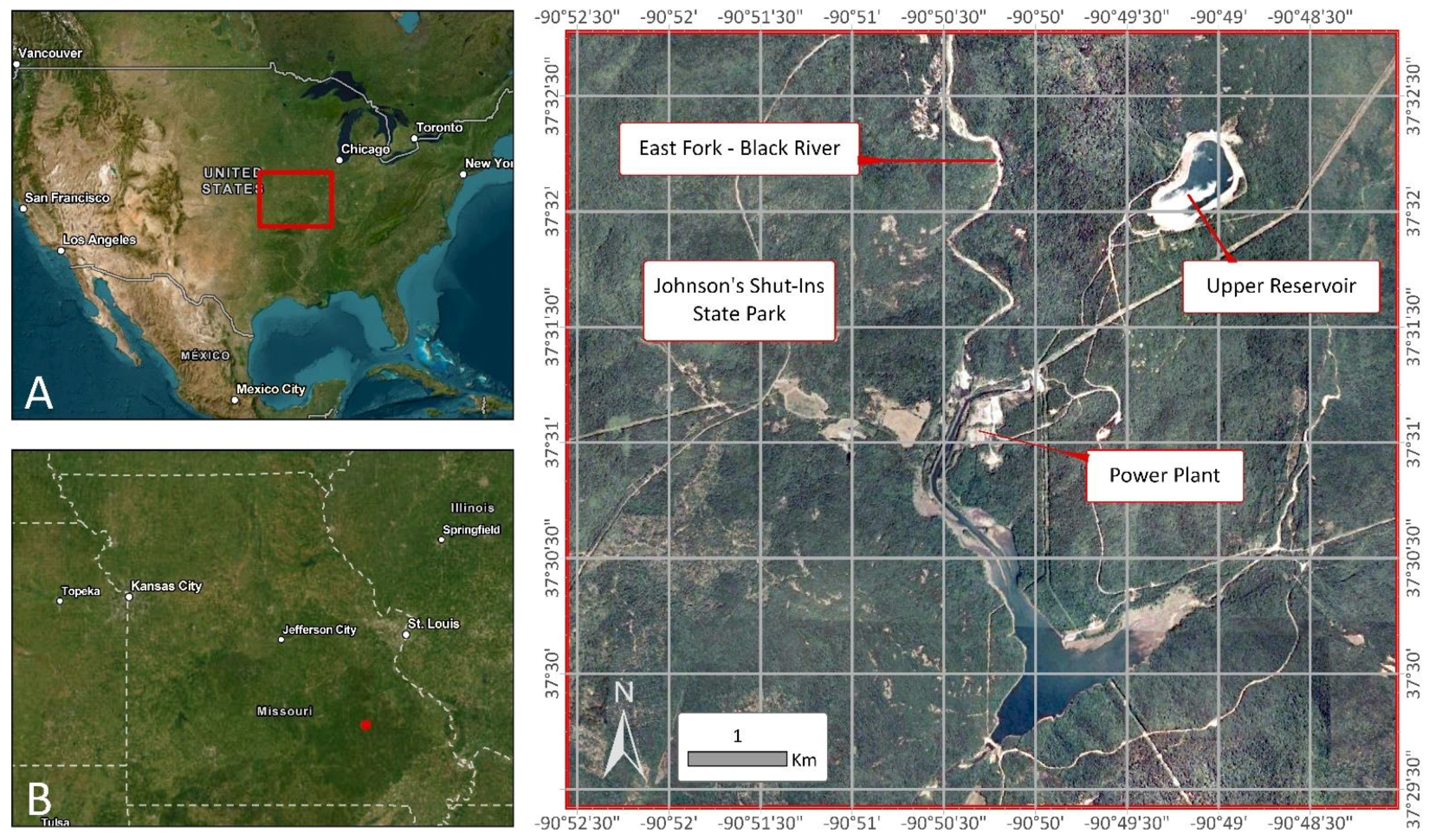
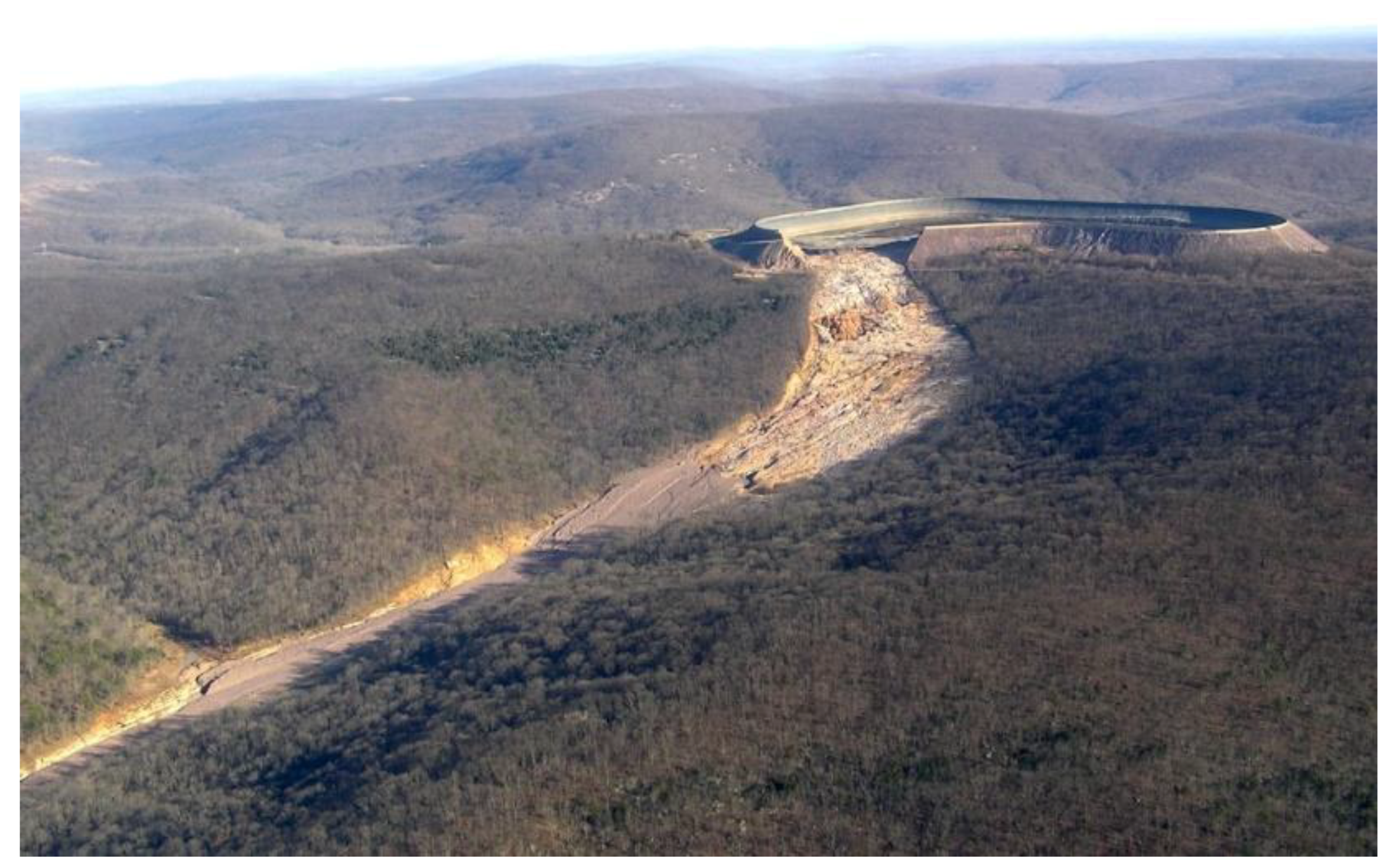
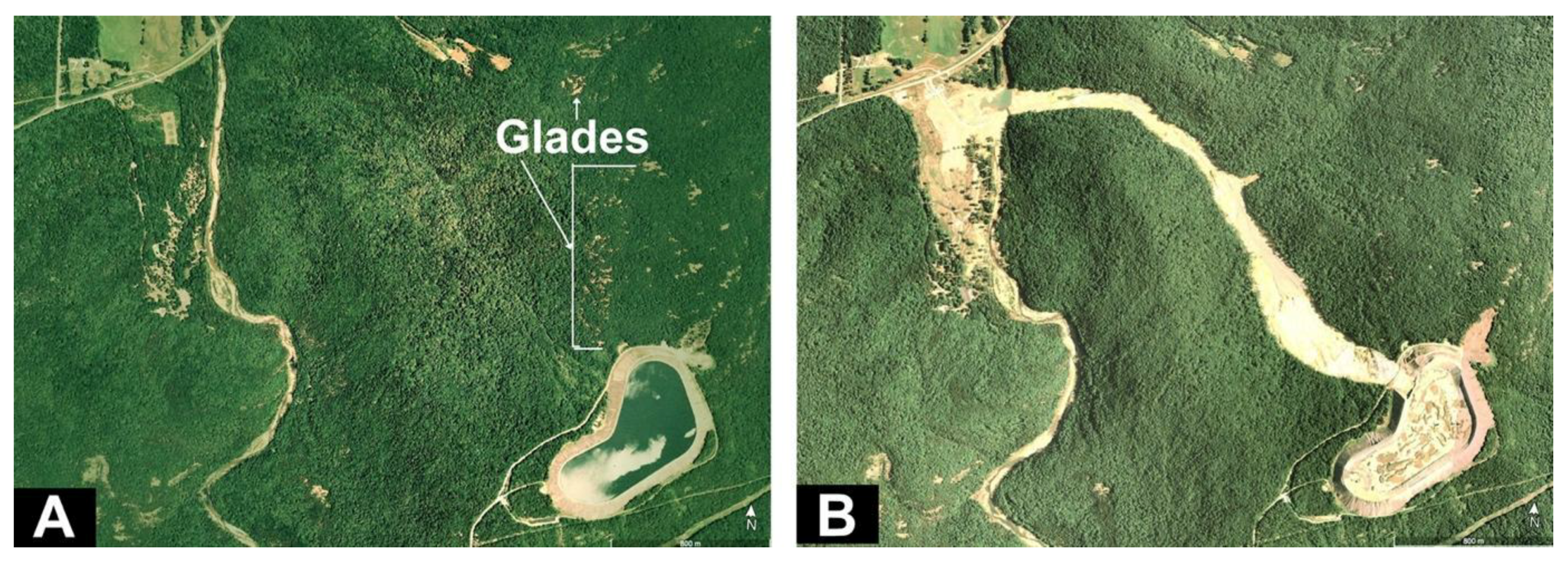
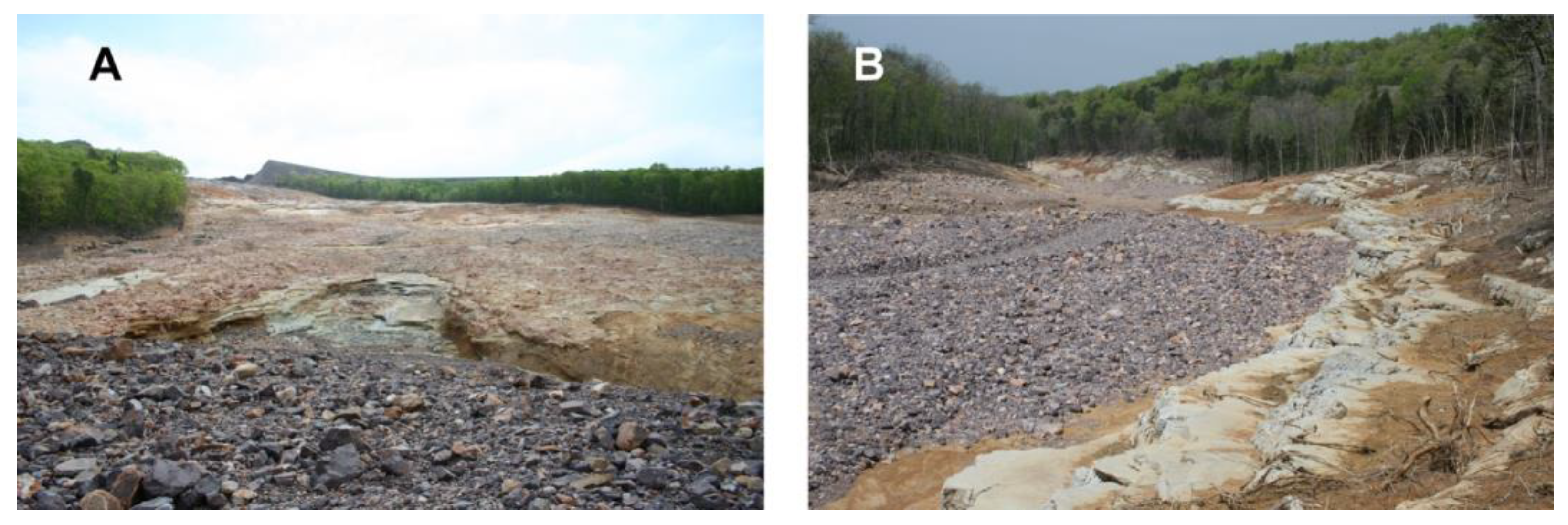
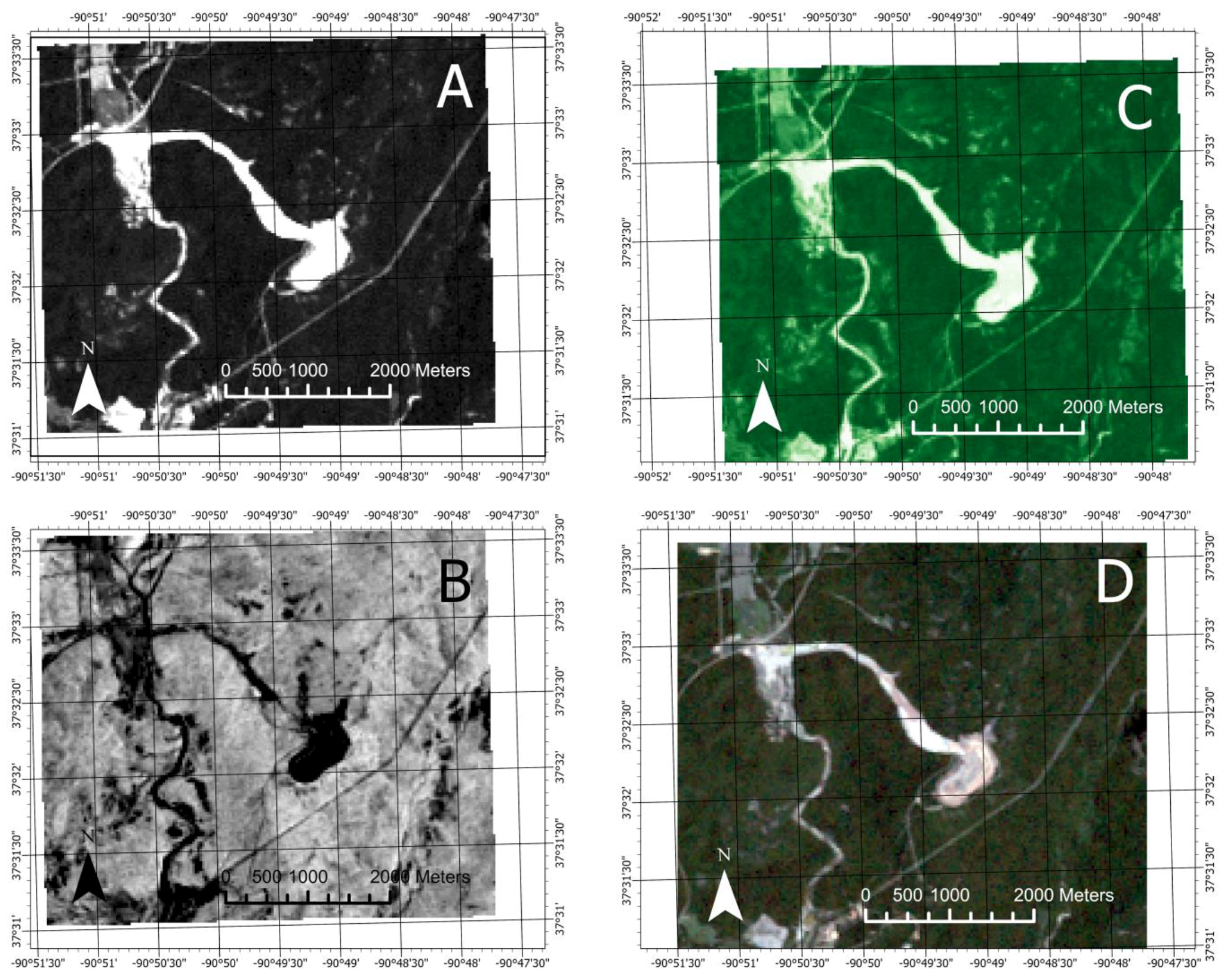
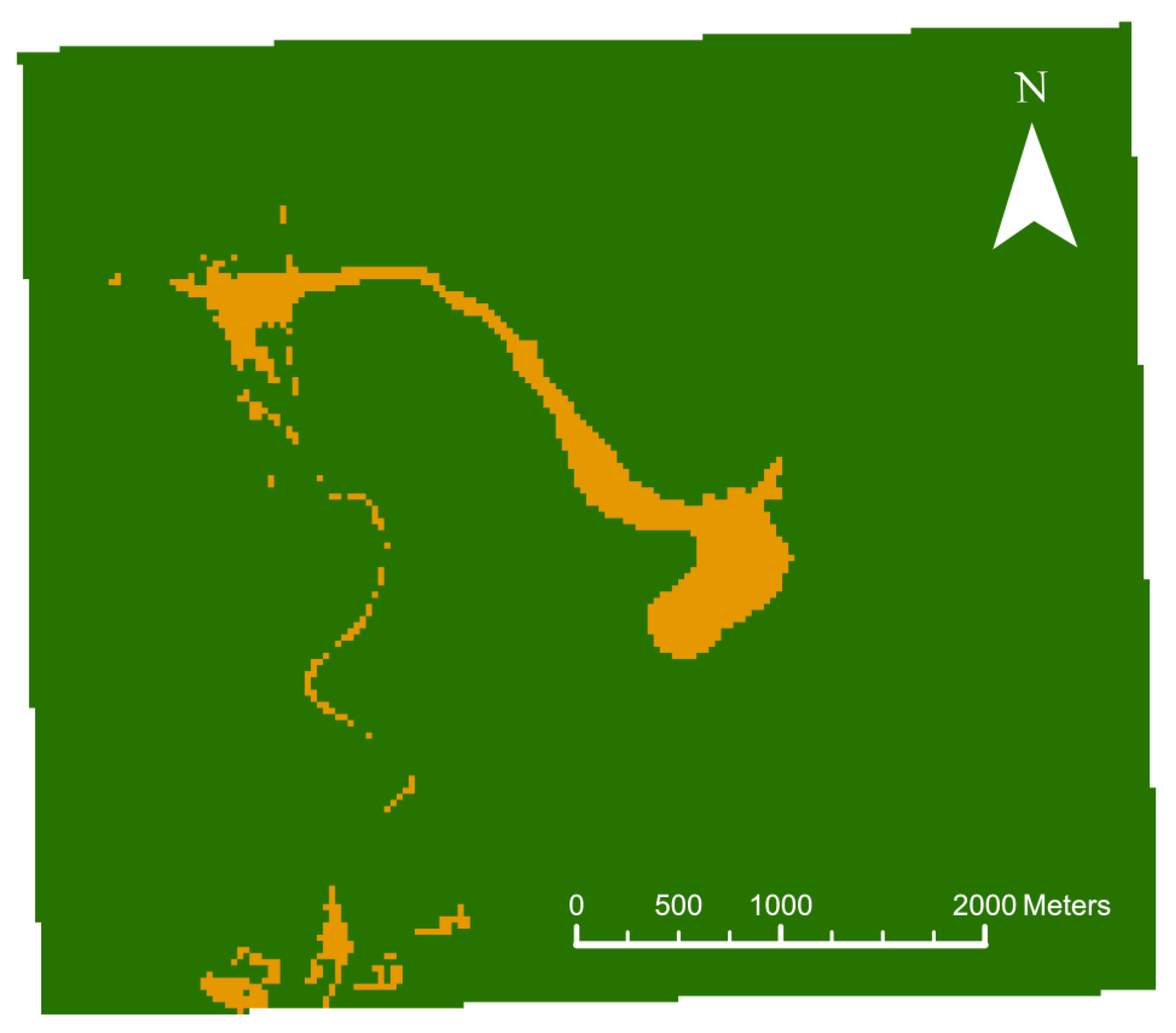
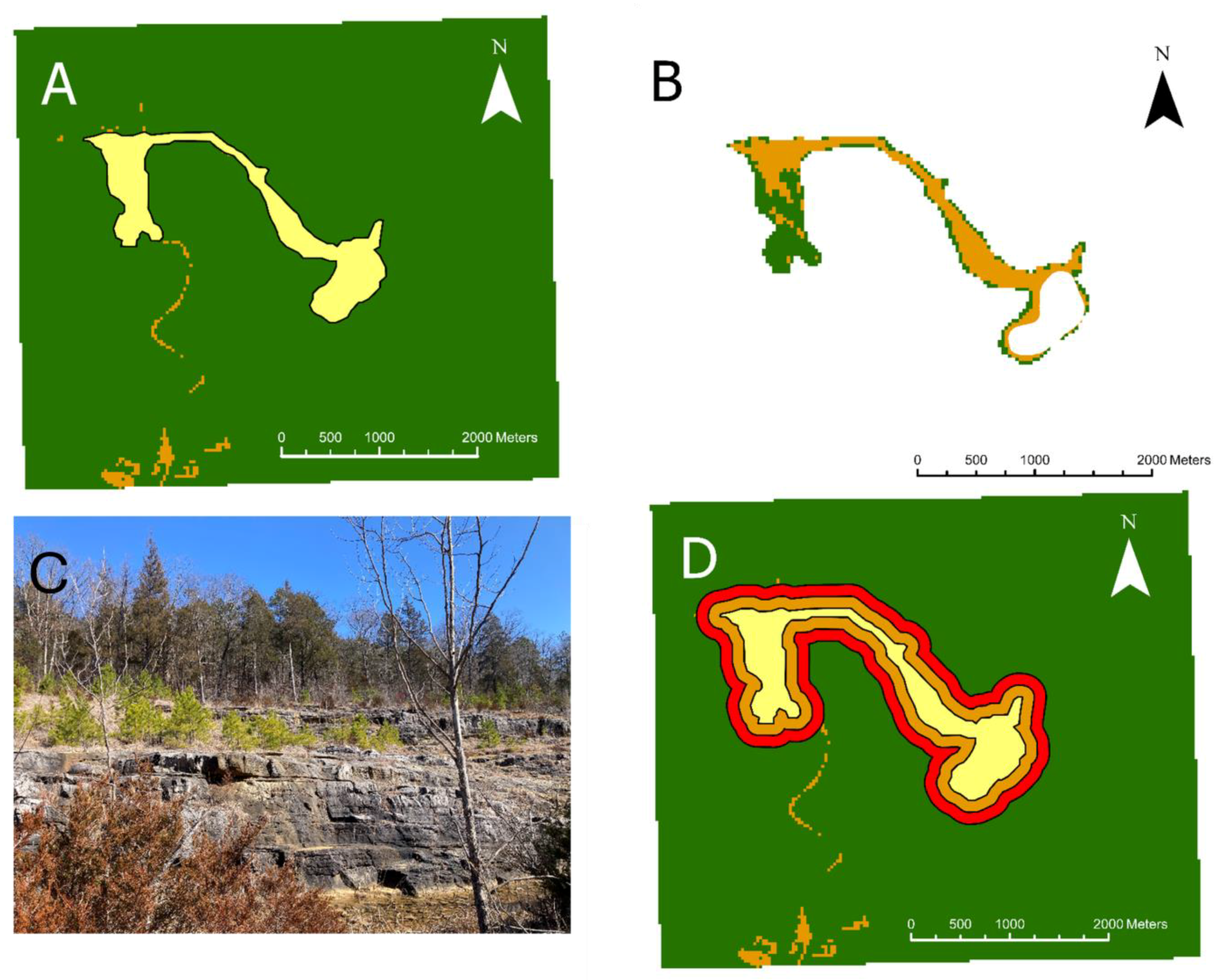
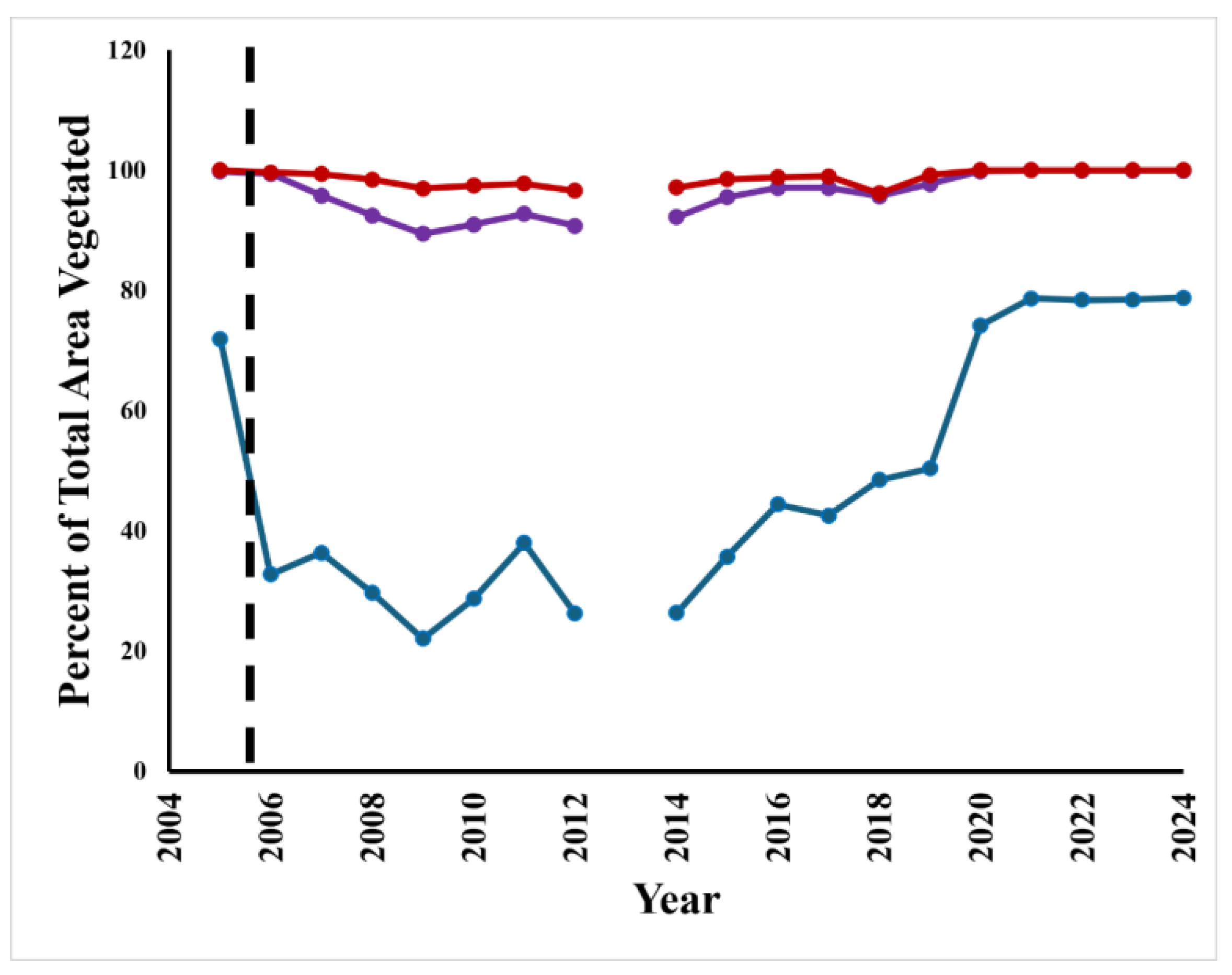

| Satellite Mission | Spatial Resolution | Dates of Images |
|---|---|---|
| Landsat 5 | 30 | 16 May 2005 6 July 2006 25 July 2007 25 June 2008 |
| Landsat 7 | 30 | 14 May 2013 |
| RapidEye-1 | 5 | 14 May 2017 |
| RapidEye-2 | 5 | 18 May 2009 30 June 2011 7 July 2018 5 June 2019 |
| RapidEye-3 | 5 | 1 May 2015 |
| RapidEye-4 | 5 | 8 May 2010 23 June 2012 4 May 2014 |
| RapidEye-5 | 5 | 10 June 2016 |
| Dove | 3 | 8 April 2020 |
| SuperDove | 3 | 23 June 2021 |
| SuperDove | 3 | 21 June 2022 |
| SuperDove | 3 | 24 June 2023 |
| SuperDove | 3 | 24 June 2024 |
| Taum Sauk Plant | Scour | Buffer 1 | Buffer 2 | |||||
|---|---|---|---|---|---|---|---|---|
| NDVI | % NDVI | % NDVI | % NDVI | |||||
| Year | Minimum | Maximum | ≤0.2 | >0.2 | ≤0.2 | >0.2 | ≤0.2 | >0.2 |
| 2005 | −0.08 | 0.78 | 28.04 | 71.96 | 0.19 | 99.81 | 0.00 | 100.00 |
| 2006 | −0.26 | 0.75 | 67.25 | 32.75 | 0.57 | 99.43 | 0.37 | 99.63 |
| 2007 | −0.08 | 0.69 | 63.62 | 36.38 | 4.19 | 95.81 | 0.61 | 99.39 |
| 2008 | −0.11 | 0.77 | 70.29 | 29.71 | 7.50 | 92.50 | 1.52 | 98.48 |
| 2009 | −0.16 | 0.80 | 77.90 | 22.10 | 10.59 | 89.41 | 3.04 | 96.96 |
| 2010 | −0.18 | 0.88 | 71.31 | 28.69 | 9.00 | 91.00 | 2.55 | 97.45 |
| 2011 | −0.18 | 0.77 | 61.99 | 38.01 | 7.26 | 92.74 | 2.23 | 97.77 |
| 2012 | −0.31 | 0.88 | 73.74 | 26.26 | 9.21 | 90.79 | 3.41 | 96.59 |
| 2013 | --- | --- | --- | --- | --- | --- | --- | --- |
| 2014 | −0.18 | 0.73 | 73.67 | 26.33 | 7.80 | 92.20 | 2.85 | 97.15 |
| 2015 | −0.27 | 0.80 | 64.31 | 35.69 | 4.49 | 95.51 | 1.48 | 98.52 |
| 2016 | −0.41 | 0.86 | 55.59 | 44.41 | 2.91 | 97.09 | 1.18 | 98.82 |
| 2017 | −0.15 | 0.79 | 57.43 | 42.57 | 2.92 | 97.08 | 1.01 | 98.99 |
| 2018 | −0.17 | 0.88 | 51.49 | 48.51 | 4.30 | 95.70 | 3.83 | 96.17 |
| 2019 | −0.08 | 0.63 | 49.61 | 50.39 | 2.29 | 97.71 | 0.78 | 99.22 |
| 2020 | −0.08 | 0.96 | 25.78 | 74.22 | 0.17 | 99.83 | 0.01 | 99.99 |
| 2021 | 0.03 | 0.96 | 21.32 | 78.68 | 0.00 | 100.00 | 0.00 | 100.00 |
| 2022 | 0.02 | 0.97 | 21.59 | 78.41 | 0.04 | 99.96 | 0.00 | 100.00 |
| 2023 | 0.05 | 0.99 | 21.52 | 78.48 | 0.04 | 99.96 | 0.00 | 100.00 |
| 2024 | 0.01 | 0.98 | 21.21 | 78.79 | 0.02 | 99.98 | 0.00 | 100.00 |
| Taxa | ||||||||||
|---|---|---|---|---|---|---|---|---|---|---|
| Date | Place | Invert | Vert | Algae | Grasses | SmallHerb | Shrubs | Trees | Total Species | Glade or Seep Species |
| 04/2006 | US | 3 | 2 | 1 | 1 | --- | --- | --- | 7 | 2 |
| SPond | 1 | 1 | 1 | 1 | 4 | --- | --- | 8 | 4 | |
| LS | --- | --- | --- | --- | --- | --- | --- | 0 | 0 | |
| LPond | --- | --- | --- | --- | --- | --- | --- | 0 | ||
| Total | 15 | 6 | ||||||||
| 08/2006 | US | 5 | 2 | 1 | 2 | --- | --- | 1 | 11 | 5 |
| SPond | 4 | 2 | 1 | 2 | 2 | 3 | 1 | 15 | 8 | |
| LS | 1 | --- | --- | 1 | 1 | 1 | --- | 4 | 2 | |
| LPond | --- | --- | 1 | 1 | --- | 1 | 1 | 4 | 3 | |
| Total | 34 | 18 | ||||||||
| 2009 | US | 4 | 4 | 1 | 3 | 5 | 2 | 2 | 21 | 8 |
| SPond | 3 | 1 | 1 | 3 | 3 | 2 | 2 | 15 | 9 | |
| LS | --- | --- | --- | 2 | 1 | 2 | 2 | 7 | 4 | |
| LPond | --- | --- | 1 | 2 | 1 | 3 | 2 | 9 | 5 | |
| Total | 52 | 26 | ||||||||
| 2010 | US | --- | --- | 1 | 3 | 5 | 3 | 2 | 14 | 5 |
| SPond | 3 | 1 | 1 | 3 | 5 | 2 | 2 | 17 | 9 | |
| LS | --- | --- | --- | 2 | 5 | 2 | 2 | 11 | 6 | |
| LPond | --- | --- | 1 | 2 | 2 | 3 | 2 | 10 | 5 | |
| Total | 52 | 25 | ||||||||
| 2011 | US | 4 | 2 | 1 | 3 | 5 | 4 | 2 | 21 | 10 |
| SPond | 3 | 2 | 1 | 3 | 6 | 2 | 2 | 19 | 11 | |
| LS | 3 | 1 | --- | 2 | 2 | 2 | 2 | 12 | 9 | |
| LPond | 4 | 1 | 1 | 2 | 3 | 3 | 2 | 16 | 10 | |
| Total | 68 | 40 | ||||||||
| 2012 | US | 4 | 2 | 1 | 3 | 5 | 4 | 3 | 22 | 10 |
| SPond | 4 | 2 | 1 | 4 | 6 | 3 | 2 | 22 | 12 | |
| LS | 4 | 2 | --- | 3 | 4 | 2 | 2 | 17 | 13 | |
| LPond | 5 | 3 | 1 | 4 | 5 | 3 | 2 | 23 | 10 | |
| Total | 84 | 45 | ||||||||
Disclaimer/Publisher’s Note: The statements, opinions and data contained in all publications are solely those of the individual author(s) and contributor(s) and not of MDPI and/or the editor(s). MDPI and/or the editor(s) disclaim responsibility for any injury to people or property resulting from any ideas, methods, instructions or products referred to in the content. |
© 2025 by the authors. Licensee MDPI, Basel, Switzerland. This article is an open access article distributed under the terms and conditions of the Creative Commons Attribution (CC BY) license (https://creativecommons.org/licenses/by/4.0/).
Share and Cite
Peterson, A.A.; DeMatteo, K.E.; Michaelides, R.J.; Braude, S.; Templeton, A.R. Time Series Analysis of Vegetation Recovery After the Taum Sauk Dam Failure. Remote Sens. 2025, 17, 1605. https://doi.org/10.3390/rs17091605
Peterson AA, DeMatteo KE, Michaelides RJ, Braude S, Templeton AR. Time Series Analysis of Vegetation Recovery After the Taum Sauk Dam Failure. Remote Sensing. 2025; 17(9):1605. https://doi.org/10.3390/rs17091605
Chicago/Turabian StylePeterson, Abree A., Karen E. DeMatteo, Roger J. Michaelides, Stanton Braude, and Alan R. Templeton. 2025. "Time Series Analysis of Vegetation Recovery After the Taum Sauk Dam Failure" Remote Sensing 17, no. 9: 1605. https://doi.org/10.3390/rs17091605
APA StylePeterson, A. A., DeMatteo, K. E., Michaelides, R. J., Braude, S., & Templeton, A. R. (2025). Time Series Analysis of Vegetation Recovery After the Taum Sauk Dam Failure. Remote Sensing, 17(9), 1605. https://doi.org/10.3390/rs17091605









